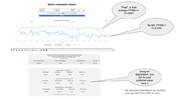I have not seen any annual change in range with teslafi, so I did not think that teslafi did it wrong, but the picture a few days back sure looked like they do.Two different API range values AFAIK. Also visible in app I suppose.
Teslafi get two different SOC’s from the API:
-The real SOC, not adjusted for cold battery.
-The cold battery SOC, that the car displays on the screen.
These can both be seen in the tesla app as you say.
The blue part is the difference between.
Teslafi shows it like this:
Without having checked, I would say that the dispayed range is strongly connected to the SOC, so a cold battery where the SOC is displayed lower also renders a shorter range displayed.
If the degradation calculation in a third part software use the real SOC instead of cold SOC as the base for the current range calculation and divides it with the ”cold range” the calculation for range at 100% will bee to low.
In my cars case it was charged shortly before my wife drowe to work and parked it outside, so the cell temp has not dropped too much yet. Only ~1% delta right now but a full day would show about 3-4% lower displayed SOC which means the displayed range would also drop 3-4%.
And a faulty degradation calculation would also show the same drop.
This without having the battery capacity changing at all.
I have not seen the BMS data for nominal full pack show any sign of decreasing in cold climate.
Cold temperatures means the battery degrades way less from calendar aging and a BMS capable of reading the actual capacity would not measrue less capacity.
As for degradation measuring purposes, the displayed range and SOC can be used as indicators for changes in the battery capacity, but due to how Tesla displays range and SOC it could show the degradation wrongly.



